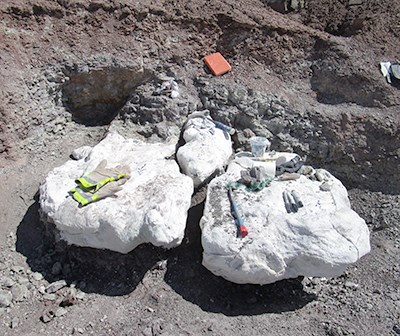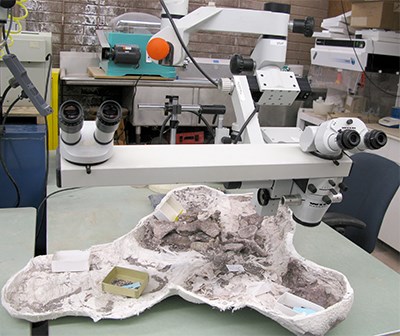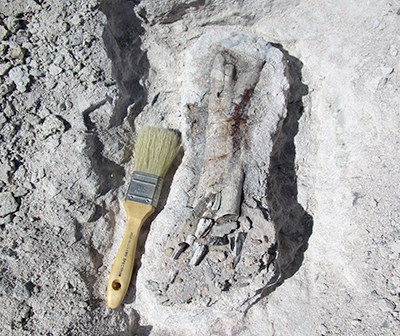
NPS Fossils in the Field Fossils can be found at Petrified Forest year-round, but most of the paleontological fieldwork occurs during the summer months when the weather is a little more predictable. Finding fossils is like a search and rescue mission; once a bone is exposed to the elements, the clock starts for all of the processes that will eventually destroy the bone unless paleontologists can get to it first. During the fieldwork season, interns, seasonal rangers, and park paleontologists walk all corners of the park to find fossils coming out of the badlands. Much of what is picked up is called "float" because it is lying on the surface of the ground. More recently, the crew has been undertaking spot excavations in order to find fossils before they weather out of the ground. When a fossil is found, paleontologists use a variety of tiny picks, brushes, and glues to dig around the bone, making sure to leave as much rock on the fossil as possible. Then, the crew makes a "jacket" around the bone with burlap strips and plaster. Each time a fossil is found, paleontologists make careful notes about its geographic position, which rock layer it came out of, what materials were used to dig it up, and lots of other contextual information like noting the weather, who was in the field crew, and what time the discovery was made. Many of the fossils found at Petrified Forest can be carefully carried back to the lab in the arms of a paleontologist, but sometimes help is needed from volunteer crews to retrieve the field jackets. 
NPS Fossils in the Lab Once the fossils are out of the ground, they are taken to the fossil preparation lab. The goal of the preparators who work there is to remove all of the rock surrounding the fossil in the field jacket, and to stabilize the fossil so that it can last in the collections in perpetuity. All of the preparation that occurs at Petrified Forest is done using a microscope and tiny tools in order to minimize damage to the fossil. Preparators also make molds and casts of fossils that can be used in museum exhibits or sent to researchers around the world.The preparation lab at the park houses equipment for bone histology, which focuses on the microstructure of fossil bone. In this process, a small piece of bone is embedded in plastic and cut into very thin slices. Those slices are then mounted on a glass slide and ground to a thickness less than that of a human hair! When the bone is that thin, scientists can view it under a special microscope to see how the bone grew during the lifetime of that animal. Once each fossil is stable, it is assigned a unique number and accessioned into the museum collections. The curator of the museum is responsible for properly housing each specimen in the storage cabinets and facilitating loans and visiting researchers. Scientists from all over the world visit Petrified Forest to study the fossils from the park. 
NPS Fossils in the Literature Paleontologists at Petrified Forest are active researchers and produce peer-reviewed scientific literature every year. When a new discovery is made, scientists make measurements, take photographs, and perform mathematical analyses to answer a particular question. What kind of animal was this? What did this animal look like? How fast did this animal grow? How did the plants and animals interact with one another? How are the fossils from this park related to those from other places? Park paleontologists are active in the academic community. They are often asked to review scientific manuscripts, participate in international paleontological conferences, and talk to local and national news outlets to provide scientific information about the park to the public. The paleontologists at Petrified Forest are working hard to bring the science and fossil resources to everyone through books, papers, museum exhibits, and public talks. See the Published Research page for a list of publications from park researchers. |
Last updated: June 13, 2024
